Hair Loss Treatments
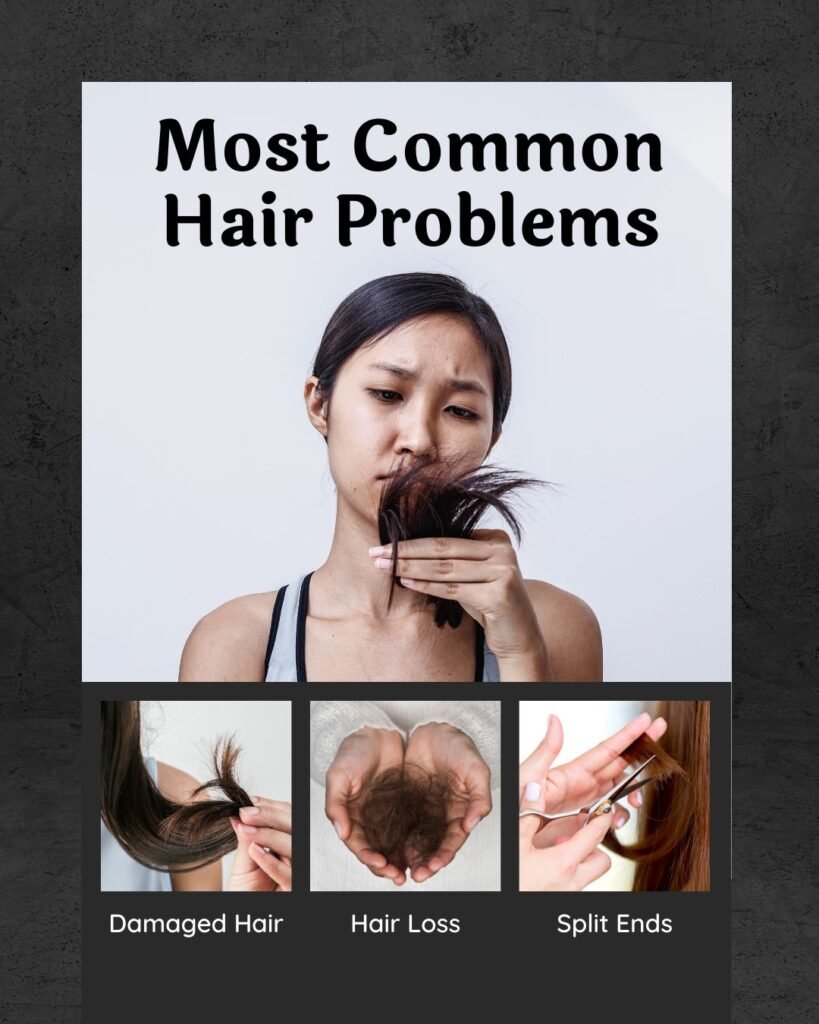
Medications
When addressing hair loss, medications are a widely adopted and effective treatment option. The key focus here is on hair loss treatments.
Minoxidil (Rogaine)Minoxidil is an over-the-counter topical solution extensively used for hair loss treatments. It is directly applied to the scalp to slow hair loss and stimulate hair regrowth. Available in liquid and foam forms, it enhances blood flow to the scalp and revitalizes hair follicles. Both men and women can benefit from its use.
Key Points:
- Application: Apply twice daily for optimal results.
- Results: Visible improvement typically seen after 3-6 months of consistent use.
- Side Effects: Possible scalp irritation and unwanted facial hair growth if not applied correctly.
Finasteride (Propecia)Finasteride is a prescription oral medication primarily used by men for hair loss treatments. It works by reducing dihydrotestosterone (DHT) levels, a hormone associated with hair loss, thereby preventing further hair loss and potentially promoting hair regrowth.
Key Points:
- Dosage: Usually taken once daily.
- Results: Improvement may begin after 3 months, with full effects often noticeable after 6-12 months.
- Side Effects: Potential side effects include decreased libido, erectile dysfunction, and a small risk of breast cancer.
Comparing Minoxidil and FinasterideMinoxidil and finasteride stand out as the most popular hair loss treatments available.
- Minoxidil: Applied topically, suitable for both genders, with minimal side effects.
- Finasteride: Oral medication for men only, addressing potential sexual side effects.
Combining Treatments
Combining minoxidil and finasteride can often yield enhanced results in treating hair loss. This dual approach tackles hair loss comprehensively and may lead to more significant improvements.
Key Points:
- Benefits: Enhanced effectiveness through combined use.
- Considerations: Always consult a healthcare provider before combining treatments.

Hair Transplant Surgery
Hair transplant surgery stands out as one of the most advanced and effective treatments available for combating hair loss. This procedure involves relocating hair follicles from a donor area, usually the back or sides of the scalp, to areas that are experiencing hair thinning or baldness. Here’s an in-depth exploration of the primary types of hair transplant surgeries and what individuals can anticipate from each.
Follicular Unit Transplantation (FUT)
Follicular Unit Transplantation (FUT) remains a widely adopted method for hair restoration. During FUT, a strip of scalp containing hair follicles is surgically removed from the donor site. Subsequently, individual follicular units are meticulously extracted from this strip and transplanted into the recipient balding regions.
Key Points:
- Procedure: Involves removing a scalp strip, extracting follicles, and transplanting them.
- Recovery: Initial healing takes approximately 10-12 days; complete results manifest within 6-12 months.
- Scarring: Leaves a linear scar at the donor site, generally concealable under surrounding hair.
Follicular Unit Extraction (FUE)
Follicular Unit Extraction (FUE) presents another effective approach in hair transplant procedures. Unlike FUT, FUE entails the extraction of individual follicular units directly from the donor area using a specialized punch tool. These follicles are then delicately implanted into the balding areas of the scalp. FUE is noted for its minimally invasive nature and shorter recovery period.
Key Points:
- Procedure: Involves extracting and transplanting individual follicles.
- Recovery: Typically involves a quicker healing process, usually within 7-10 days.
- Scarring: Results in tiny, dot-like scars that are less conspicuous compared to FUT’s linear scar.
Comparing FUT and FUE
Both FUT and FUE offer effective solutions for hair loss, each with distinct advantages and considerations depending on individual needs. Here’s a comparative overview to help determine which option may be more suitable:
Key Points:
- FUT: Preferable for addressing larger areas of baldness, though it results in a linear scar and involves a slightly longer recovery period.
- FUE: Ideal for smaller areas requiring restoration, characterized by minimal scarring and a faster recovery timeline.
What to Expect
Undergoing hair transplant surgery encompasses several phases, starting from the initial consultation to the recovery phase. Here’s a concise outline of what to anticipate throughout the process:
- Consultation: Collaborate with your surgeon to outline goals and establish a tailored treatment plan.
- Procedure: Typically spans 4-8 hours, contingent on the number of follicular units being transplanted.
- Recovery: Initial recuperation spans approximately 1-2 weeks, culminating in full aesthetic results emerging within 6-12 months.
Key Points:
- Pre-Procedure: Adhere to pre-operative guidelines provided by your surgeon, which may include medication adjustments.
- Post-Procedure: Follow detailed aftercare instructions crucial for facilitating optimal healing and achieving desired outcomes.
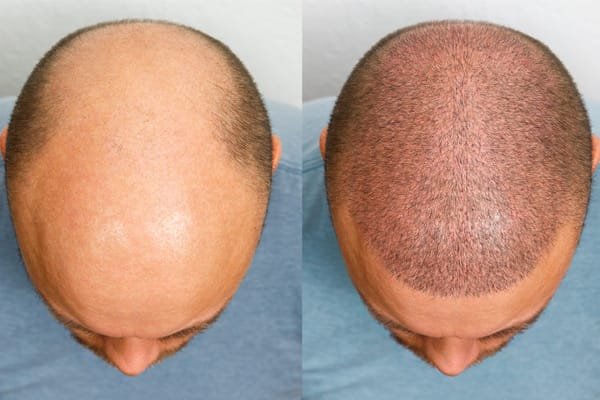
Laser Therapy
Laser therapy has emerged as a popular non-invasive solution for combating hair loss, celebrated for its effectiveness and user-friendly nature. This innovative treatment harnesses the power of low-level laser light to stimulate hair follicles and encourage hair regrowth.
Understanding How Laser Therapy Works
Laser therapy, scientifically known as Low-Level Laser Therapy (LLLT), operates by emitting red light at specific wavelengths directly onto the scalp. This light penetrates the skin and is absorbed by cells within the hair follicles, triggering an increase in cellular activity. By enhancing blood circulation to the scalp and revitalizing dormant follicles, laser therapy promotes the growth of healthier, thicker hair strands.
Key Points:
- Mechanism: Red light stimulates hair follicles, improving scalp blood flow.
- Safety: Non-invasive and generally safe, with minimal side effects.
Types of Laser Therapy Devices
Various devices are available for laser hair loss treatment, catering to both clinical settings and convenient home use.
Laser Combs
Laser combs are handheld devices that integrate laser therapy with the act of brushing. They offer a straightforward method for regular treatment in the comfort of home.
Key Points:
- Usage: Simply comb through hair for 15 minutes, three times weekly.
- Convenience: Portable and user-friendly.
Laser Helmets and Caps
For a hands-free experience, laser helmets and caps cover a larger scalp area. Designed for home use, these devices provide comprehensive laser treatment.
Key Points:
- Usage: Wear for 20-30 minutes, several times weekly.
- Coverage: Ensures uniform exposure across the entire scalp.
Benefits of Laser Therapy
Laser therapy presents several advantages as a hair loss treatment option, appealing to individuals seeking effective yet non-invasive solutions.
Key Points:
- Non-Invasive: No surgical procedures or needles required.
- Convenient: Easily administered at home with personal devices.
- No Downtime: Patients can resume daily activities immediately post-treatment.
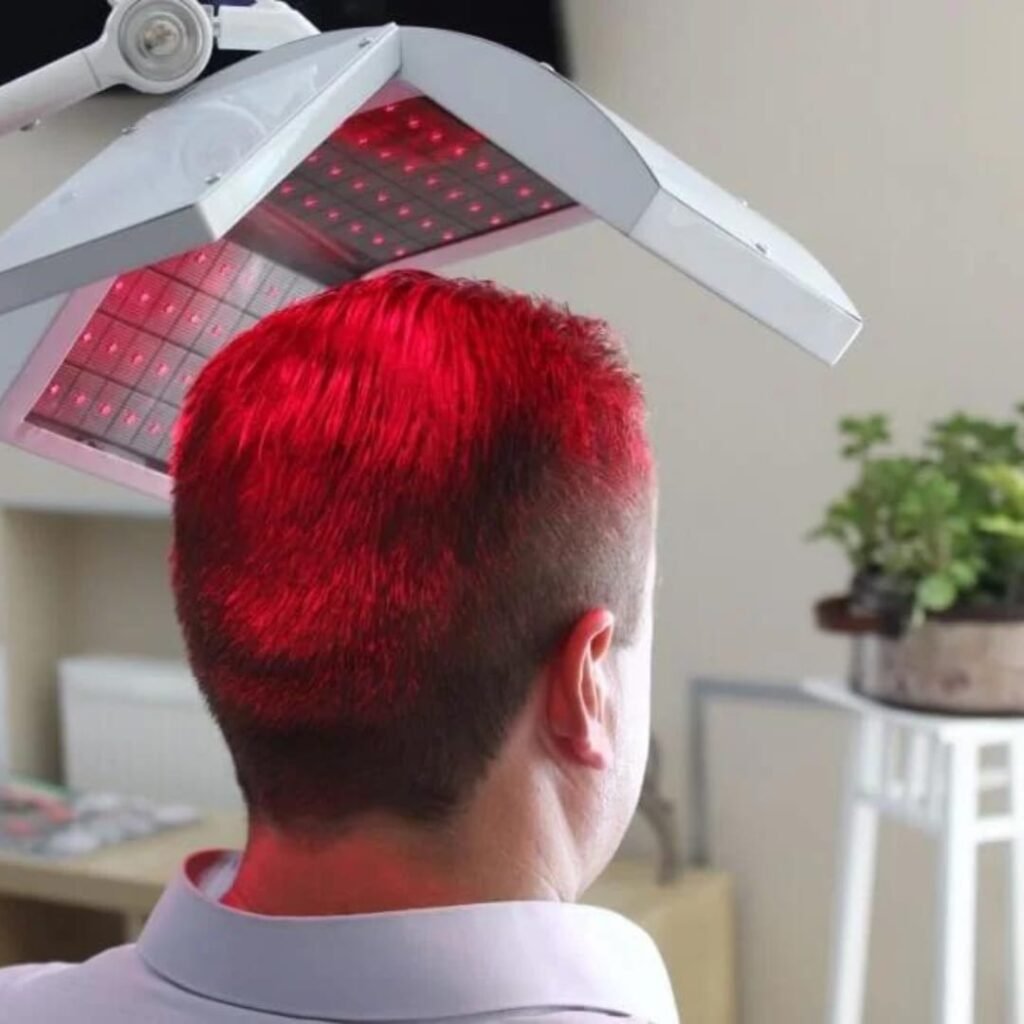
Effectiveness of Laser Therapy
Clinical studies have shown that laser therapy can be effective in promoting hair growth and reducing hair loss. However, results can vary based on individual factors such as the extent of hair loss and the consistency of treatment.
Key Points:
- Results: Some users may see improvements within 3-6 months of regular use.
- Consistency: Regular and consistent use is crucial for optimal results.
Platelet-Rich Plasma (PRP) Therapy
Platelet-Rich Plasma (PRP) Therapy is an advanced hair loss treatment that utilizes your body’s natural growth factors to stimulate hair follicles and promote hair growth. This minimally invasive procedure has gained popularity for its effectiveness and safety.
How PRP Therapy Works
PRP Therapy involves drawing a small amount of your blood, processing it to concentrate the platelets, and then injecting this platelet-rich plasma into the scalp. Platelets contain growth factors that aid in tissue repair and regeneration, which can help stimulate dormant hair follicles and promote new hair growth.
Key Points:
- Procedure: Blood is drawn, processed to concentrate platelets, and injected into the scalp.
- Growth Factors: Platelets release growth factors that stimulate hair follicles and promote growth.
Benefits of PRP Therapy
PRP Therapy offers several benefits as a hair loss treatment, making it an appealing option for those seeking non-surgical interventions.
Key Points:
- Natural Treatment: Uses your own blood, reducing the risk of allergic reactions.
- Minimally Invasive: Involves injections without the need for surgery.
- Promotes Natural Hair Growth: Stimulates your existing hair follicles.
The PRP Therapy Procedure
Understanding the PRP Therapy procedure can help you know what to expect during this hair loss treatment.
- Consultation: Initial consultation with a specialist to determine suitability.
- Blood Draw: A small amount of blood is drawn from your arm.
- Processing: Blood is placed in a centrifuge to concentrate the platelets.
- Injection: Platelet-rich plasma is injected into targeted areas of the scalp.
Key Points:
- Duration: The procedure typically takes about 60-90 minutes.
- Pain: Minimal discomfort; local anesthesia can be used to reduce pain.
Effectiveness and Results
PRP Therapy has shown promising results in promoting hair growth and reducing hair loss. However, individual results can vary.
Key Points:
- Results Timeline: Some patients may see improvement within 3-6 months, with continued improvement over a year.
- Consistency: Multiple sessions (usually 3-4) spaced a month apart are often recommended for optimal results.
Safety and Side Effects
PRP Therapy is generally safe, but like any medical procedure, it can have side effects.
Key Points:
- Common Side Effects: Mild pain at the injection site, redness, and swelling.
- Rare Complications: Infection or injury to blood vessels or nerves, though these are very rare.
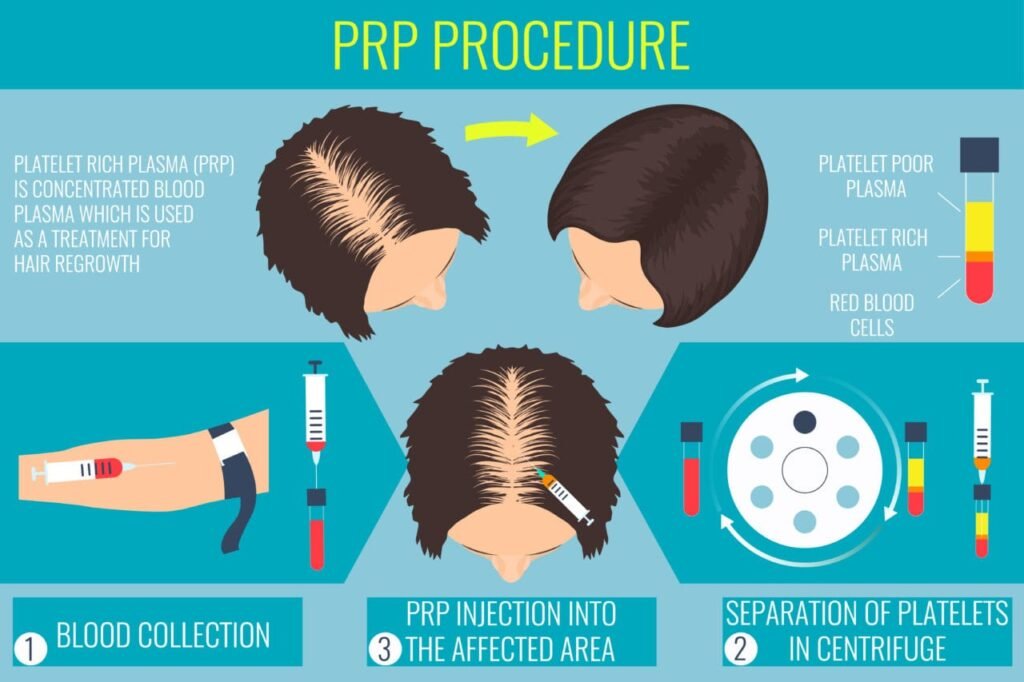
Nutritional Supplements
Nutritional supplements play a vital role in hair loss treatments by addressing deficiencies that may contribute to hair thinning and loss. Ensuring your body receives the right vitamins and minerals can support hair health and promote growth.
Key Nutritional Supplements for Hair Loss
Here are some of the most effective supplements that can aid in preventing and treating hair loss:
Biotin (Vitamin B7)
Biotin is a B-vitamin that is essential for healthy hair, skin, and nails. It helps in the production of keratin, a protein that makes up the structure of hair.
Key Points:
- Sources: Found in foods like eggs, nuts, and whole grains, but also available in supplement form.
- Dosage: Typically, 2.5 to 5 mg per day.
- Benefits: Strengthens hair and promotes growth.
Vitamin D
Vitamin D is crucial for hair follicle health. A deficiency in vitamin D can lead to hair thinning and loss.
Key Points:
- Sources: Sunlight, fortified foods, and supplements.
- Dosage: Recommended daily intake is 600-800 IU, but higher doses may be needed for deficiency.
- Benefits: Supports hair follicle cycling and growth.
Iron
Iron deficiency is a common cause of hair loss, particularly in women. Iron helps red blood cells carry oxygen to hair follicles, which is essential for growth.
Key Points:
- Sources: Red meat, spinach, lentils, and iron supplements.
- Dosage: 18 mg per day for women and 8 mg per day for men, but higher doses may be prescribed for deficiency.
- Benefits: Prevents hair loss and promotes regrowth.
Consider adding an image of iron-rich foods or iron supplements to demonstrate sources.
Zinc
Zinc plays a crucial role in hair tissue growth and repair. It also helps keep the oil glands around hair follicles working properly.
Key Points:
- Sources: Meat, shellfish, legumes, seeds, and zinc supplements.
- Dosage: 8 mg per day for women and 11 mg per day for men.
- Benefits: Supports healthy hair growth and repair.
Omega-3 Fatty Acids
Omega-3 fatty acids nourish the hair, support thickening, and reduce inflammation that can lead to hair loss.
Key Points:
- Sources: Fatty fish (like salmon), flaxseeds, chia seeds, and omega-3 supplements.
- Dosage: 250-500 mg of combined EPA and DHA daily.
- Benefits: Promotes scalp health and hair growth.
Multivitamins
Multivitamins can provide a balanced mix of essential vitamins and minerals that support overall hair health. They are particularly beneficial if your diet lacks variety.
Key Points:
- Contents: Usually contain vitamins A, C, D, E, B-complex, iron, zinc, and other essential nutrients.
- Dosage: Follow the recommended daily allowance (RDA) on the product label.
- Benefits: Ensures you receive a broad spectrum of nutrients for optimal hair health.

Lifestyle and Home Remedies
Lifestyle changes and home remedies can be effective hair loss treatments that help manage and potentially reverse hair thinning and loss. These natural approaches often complement other treatments and can be easily integrated into daily routines.
Healthy Diet
A balanced diet rich in vitamins and minerals is essential for hair health. Nutrients such as protein, iron, and vitamins A, C, and E play a critical role in maintaining healthy hair growth.
Key Points:
- Protein: Found in lean meats, eggs, and legumes, protein is crucial for hair structure.
- Iron: Iron-rich foods like spinach and red meat help carry oxygen to hair follicles.
- Vitamins: Fruits and vegetables provide essential vitamins for hair health.
Stress Management
Stress can contribute to hair loss. Managing stress through relaxation techniques and healthy lifestyle choices can promote better hair health.
Key Points:
- Techniques: Practices such as yoga, meditation, and deep breathing can reduce stress.
- Lifestyle: Regular exercise and adequate sleep are also important for managing stress.
Scalp Massage
Regular scalp massages can improve blood circulation to the scalp, which may stimulate hair growth and improve hair thickness.
Key Points:
- Technique: Use your fingertips to gently massage your scalp in circular motions for a few minutes each day.
- Benefits: Enhances blood flow to hair follicles and can be relaxing.
Essential Oils
Certain essential oils are believed to promote hair growth and improve scalp health. Popular choices include rosemary, lavender, and peppermint oils.
Key Points:
- Application: Mix a few drops of essential oil with a carrier oil (like coconut or jojoba oil) and massage into the scalp.
- Benefits: May stimulate hair growth and reduce scalp inflammation.
Avoiding Harsh Treatments
Limiting the use of harsh hair treatments and styling practices can help prevent further hair damage and loss.
Key Points:
- Heat Tools: Reduce the use of blow dryers, curling irons, and straighteners.
- Chemical Treatments: Avoid frequent dyeing, perming, and chemical straightening.
- Gentle Care: Use gentle shampoos and conditioners and avoid tight hairstyles that pull on the hair.
Natural Remedies
Some natural ingredients are believed to support hair health and growth. Popular home remedies include:
Aloe Vera
Aloe vera is known for its soothing properties and can be beneficial for the scalp.
Key Points:
- Application: Apply pure aloe vera gel directly to the scalp and leave it on for about an hour before washing it off.
- Benefits: Helps soothe the scalp and may promote hair growth.
Onion Juice
Onion juice is rich in sulfur, which can boost collagen production and help with hair regrowth.
Key Points:
- Application: Extract juice from an onion and apply it to the scalp for about 15-30 minutes before washing it out.
- Benefits: May stimulate hair follicles and improve hair growth.
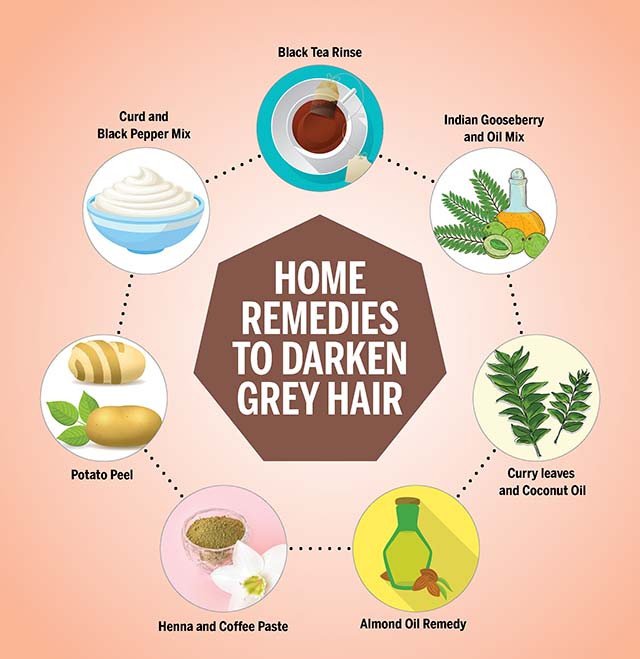
Scalp Micropigmentation (SMP)
Scalp Micropigmentation (SMP) is a non-surgical hair loss treatment that provides the appearance of fuller hair by using specialized pigments to create the illusion of hair follicles on the scalp. This cosmetic procedure is an effective solution for those looking to address thinning hair or baldness.
How Scalp Micropigmentation Works
SMP involves using micro-needles to deposit tiny dots of pigment into the scalp. These dots mimic the look of natural hair follicles and can create the appearance of a shaved head or add density to thinning areas.Key Points:
- Procedure: Tiny dots of pigment are applied to the scalp with a micro-needle.Appearance: Creates the illusion of hair follicles and a fuller hairline.
Benefits of Scalp Micropigmentation
Scalp Micropigmentation offers several benefits as a hair loss treatment, making it an appealing option for many individuals.Key Points:
- Non-Surgical: No incisions or stitches are required.Immediate Results: The appearance of fuller hair is visible immediately after treatment.Low Maintenance: Requires minimal upkeep compared to other hair loss treatments.
The SMP Procedure
Understanding the SMP procedure can help you know what to expect during this hair loss treatment.
- Consultation: Discuss your desired look and choose the right pigment shade.Preparation: The scalp is cleaned and prepped for the procedure.Application: Pigment is applied using micro-needles in a pattern that mimics natural hair follicles.Aftercare: Follow specific aftercare instructions to ensure proper healing and optimal results.
Key Points:
- Duration: Each session typically lasts 2-4 hours.Sessions: Multiple sessions (usually 2-3) are often needed to achieve the desired look.
Effectiveness and Longevity
SMP provides a realistic and long-lasting solution for hair loss. However, periodic touch-ups may be necessary to maintain the appearance.Key Points:
- Longevity: Results can last for 4-6 years before a touch-up is needed.Maintenance: Occasional touch-ups help keep the pigment looking fresh.
Safety and Side Effects
SMP is generally safe, but as with any cosmetic procedure, there can be risks and side effects.Key Points:
- Common Side Effects: Redness, itching, and slight swelling at the treatment site.Rare Complications: Infection or allergic reaction to the pigment, though these are uncommon.

Wigs and Hairpieces
Wigs and hairpieces are versatile hair loss treatments that offer immediate solutions for individuals experiencing hair thinning or baldness. Whether used temporarily or long-term, these options provide a natural-looking way to enhance hair appearance.
Types of Wigs and Hairpieces
There are various types of wigs and hairpieces available to suit different preferences and needs:
Synthetic Wigs
Synthetic wigs are made from synthetic fibers designed to mimic the look and feel of natural hair. They are affordable and require less maintenance than human hair wigs.
Key Points:
- Appearance: Come in various styles, colors, and textures.
- Care: Wash and style according to manufacturer instructions.
Human Hair Wigs
Human hair wigs are made from real human hair, providing a natural look and feel. They can be styled and colored just like natural hair.
Key Points:
- Quality: Offer realistic appearance and versatility in styling.
- Maintenance: Require regular care similar to natural hair.
Hairpieces and Extensions
Hairpieces and extensions are used to add volume or cover specific areas of hair loss. They can be clipped, taped, or bonded to existing hair.
Key Points:
- Versatility: Available in various lengths, colors, and styles.
- Application: Applied using clips, tapes, or adhesives.
Benefits of Wigs and Hairpieces
Wigs and hairpieces offer several benefits as hair loss treatments, making them popular among individuals looking for immediate solutions:
Key Points:
- Instant Results: Provides immediate coverage for hair loss.
- Versatility: Can be worn daily or for special occasions.
- Confidence Boost: Enhances self-esteem by restoring a natural appearance.
Choosing the Right Wig or Hairpiece
When selecting a wig or hairpiece, consider factors such as style, color, material, and comfort. A consultation with a wig specialist can help you find the best option for your preferences and lifestyle.
Key Points:
- Fit: Ensure proper fit for comfort and natural appearance.
- Style: Choose a style that complements your face shape and lifestyle.
- Maintenance: Follow care instructions to prolong the lifespan of your wig or hairpiece.
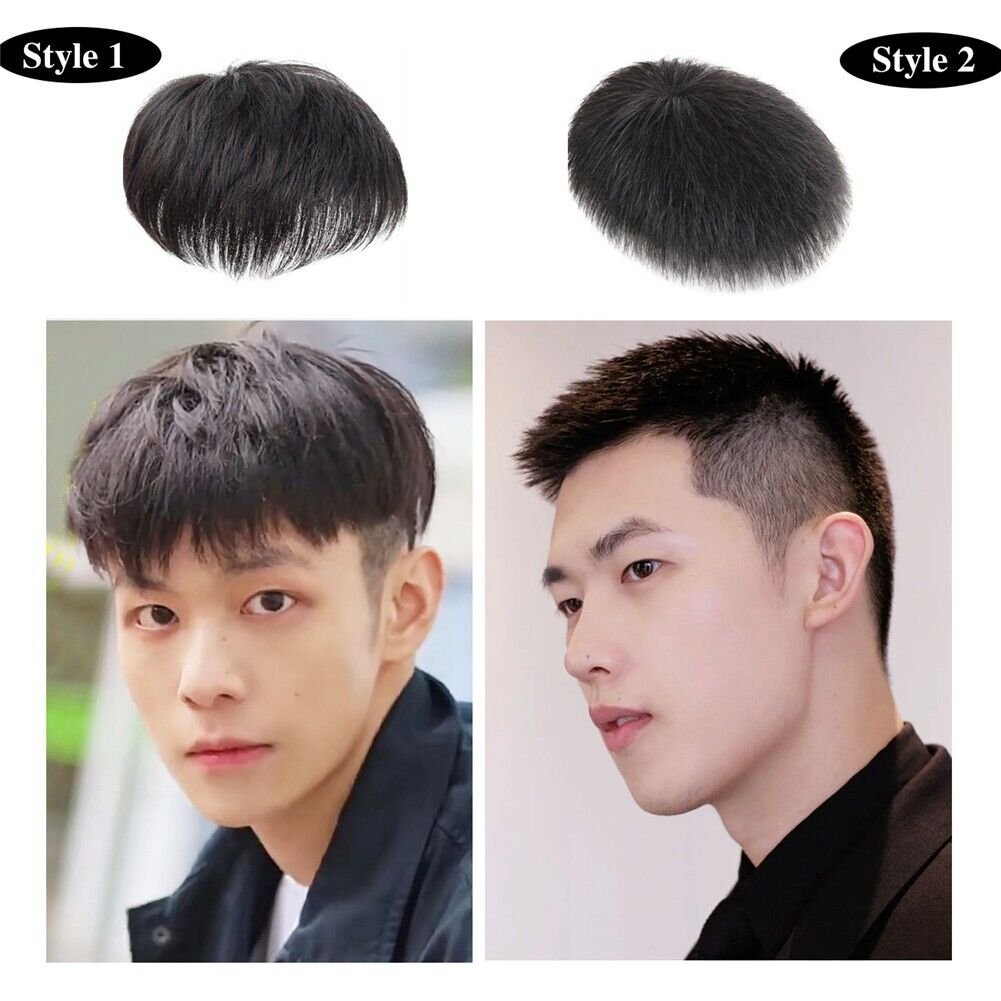
Consultation with a Dermatologist or Trichologist
A consultation with a dermatologist or trichologist is crucial for individuals experiencing hair loss, as these specialists can provide expert guidance and personalized hair loss treatments based on the underlying cause and type of hair loss.
Importance of Consultation
Consulting with a dermatologist or trichologist allows for a comprehensive evaluation of your hair loss concerns. These specialists have the expertise to diagnose the cause of hair loss and recommend appropriate treatments.
Key Points:
- Diagnosis: Determine whether the hair loss is due to genetics, hormonal changes, medical conditions, or other factors.
- Personalized Treatment Plan: Tailor treatment options based on your specific needs and preferences.
What to Expect During the Consultation
During your consultation with a dermatologist or trichologist, several key steps will typically be involved:
- Medical History: Discuss your medical history, including any medications you are taking and your family history of hair loss.
- Scalp Examination: Conduct a thorough examination of your scalp and hair follicles to assess the extent and pattern of hair loss.
- Diagnostic Tests: Depending on the findings, additional tests such as blood tests or scalp biopsies may be recommended to determine the underlying cause.
Key Points:
- Open Communication: Be prepared to discuss your concerns and ask questions about potential treatments.
- Education: Receive information about the different types of hair loss and available treatment options.
Treatment Options
Based on the diagnosis, your dermatologist or trichologist may recommend various hair loss treatments:
- Medications: Prescribe medications such as minoxidil or finasteride to promote hair growth.
- Procedures: Recommend procedures like PRP therapy or hair transplant surgery for more advanced cases.
- Lifestyle Changes: Suggest changes in diet, stress management techniques, or adjustments in hair care routines.
After discussing treatment options, your dermatologist or trichologist will outline a follow-up plan to monitor your progress and adjust treatments if necessary.
Key Points:
- Monitoring: Regular follow-up appointments to assess treatment efficacy and address any concerns.
- Support: Receive ongoing support and guidance throughout your hair loss treatment journey.

Factors to Consider
When exploring hair loss treatments, several factors should be taken into account to determine the most suitable option for your needs and preferences. Considering these factors can help you make an informed decision and achieve effective results in managing hair loss.
Underlying Cause of Hair Loss
Identifying the underlying cause of your hair loss is essential for choosing the right treatment. Common causes include genetics, hormonal changes, medical conditions, and lifestyle factors.
Key Points:
- Consultation: Consult with a dermatologist or trichologist to diagnose the cause of your hair loss.
- Treatment Suitability: Some treatments may be more effective for certain types of hair loss than others.
Severity of Hair Loss
Assess the severity of your hair loss to determine the appropriate treatment approach. Mild to moderate hair loss may respond well to topical treatments or lifestyle changes, while more severe cases may require advanced therapies like PRP or hair transplant surgery.
Key Points:
- Classification: Use scales like the Norwood scale for male pattern baldness or Ludwig scale for female pattern baldness to gauge severity.
- Treatment Options: Tailor treatments based on the extent of hair loss and desired outcomes.
Treatment Effectiveness
Research the effectiveness of various hair loss treatments to understand their success rates and potential results. Consider factors such as patient testimonials, clinical studies, and before-and-after photos to gauge efficacy.
Key Points:
- Evidence-Based: Look for treatments backed by scientific research and clinical trials.
- Realistic Expectations: Understand that results may vary based on individual factors and adherence to treatment protocols.
Safety and Side Effects
Evaluate the safety profile and potential side effects of each hair loss treatment option. Some treatments may carry risks such as allergic reactions, scalp irritation, or more serious complications in rare cases.
Key Points:
- Consultation: Discuss potential side effects with a healthcare provider before starting treatment.
- Risk-Benefit Analysis: Balance the potential benefits of treatment against the associated risks.
Cost and Affordability
Consider the cost of hair loss treatments, including initial expenses and ongoing maintenance. Factors such as treatment duration, required sessions, and product longevity can influence overall affordability.
Key Points:
- Budget: Determine a budget that aligns with your financial capabilities.
- Insurance Coverage: Check if your health insurance covers any part of the treatment costs.
Lifestyle and Convenience
Evaluate how well a hair loss treatment fits into your lifestyle and daily routine. Some treatments require regular application or maintenance, while others may offer more convenience and flexibility.
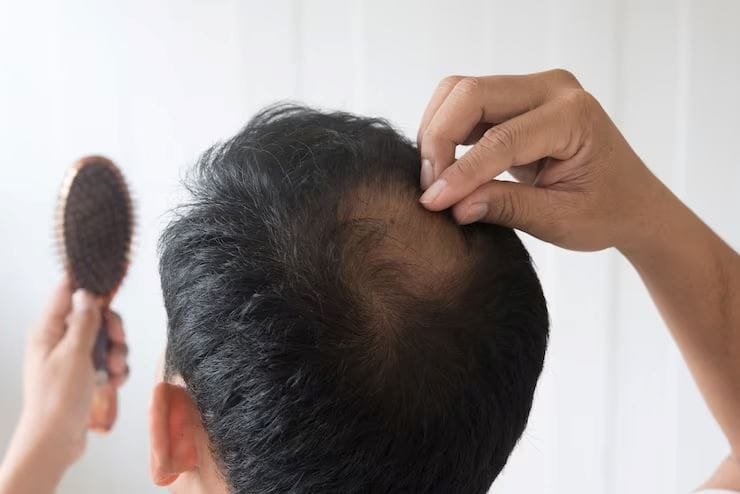
Key Points:
- Time Commitment: Consider the time needed for treatment application or sessions.
- Ease of Use: Choose treatments that align with your lifestyle and preferences.

